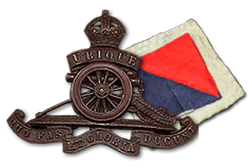
45th Light Anti-Aircraft Regiment, Royal Artillery, was a British Territorial Army (TA) unit formed in July 1940. After serving in Anti-Aircraft Command during the Battle of Britain and The Blitz, it went to North Africa as part of Operation Torch and fought in Tunisia and Italy. It ended World War II as a garrison regiment.
26th (London) Anti-Aircraft Brigade was an Air Defence formation of the British Army during the Second World War. It defended London during the Blitz.
28th Anti-Aircraft Brigade was an air defence formation of the British Territorial Army created in 1925 to command anti-aircraft units in Kent and around the militarily important Medway Towns, which it defended during the Second World War. In 1940 the brigade was responsible for the defences on the south side of the Thames Estuary including the Royal Naval Dockyard at Chatham and the Port of Dover. The brigade was heavily engaged throughout the Battle of Britain, in the summer of 1940, and The Blitz, from autumn 1940 to spring 1941, operating a total of 70 heavy anti-aircraft (HAA) guns controlled from a gun operations room (GOR) at Chatham. During 1942 many of the brigade's experienced units were transferred to active theatres overseas. Increasingly the brigade included women of the Auxiliary Territorial Service (ATS).
The 30th (Northumbrian) Anti-Aircraft Brigade was an air defence formation of Britain's Territorial Army from 1936 until 1955, which defended Tyneside and Sunderland during the Second World War.
The 31st Anti-Aircraft Brigade was an air defence formation of Britain's Territorial Army from 1936 until 1948. During the Second World War it defended West Yorkshire and later participated in the North West Europe campaign.
The 32nd (Midland) Anti-Aircraft Brigade was an air defence formation of Anti-Aircraft Command in Britain's Territorial Army (TA) from 1936 to 1955, charged with defending the East Midlands of England.
The 34th Anti-Aircraft Brigade was an air defence formation of Anti-Aircraft Command in the British Territorial Army formed shortly before the outbreak of the Second World War. It defended the West Midlands of England during The Blitz.
The 33rd (Western) Anti-Aircraft Brigade was an air defence formation of Anti-Aircraft Command of the Territorial Army, part of the British Army, formed shortly before the outbreak of the Second World War. It defended Merseyside and West Lancashire during The Blitz.
35th Anti-Aircraft Brigade was an air defence formation of Anti-Aircraft Command in the British Territorial Army (TA) formed shortly before the outbreak of the Second World War. It defended the important naval base of Portsmouth during The Blitz.

The 51st (Highland) Searchlight Regiment, Royal Artillery was a Scottish unit of Britain's Territorial Army (TA) formed for air defence just before World War II. It later served as an anti-aircraft (AA) artillery unit in the North West Europe Campaign 1944–45, and continued in the postwar TA into the 1950s.

The 71st (Forth) Heavy Anti-Aircraft Regiment, Royal Artillery was an air defence unit of Britain's Territorial Army (TA) formed in Scotland just before World War II. It served in North Africa and Italy during the war. Its' successors continue to serve in the Army Reserve as part of the Royal Logistic Corps.
36th (Scottish) Anti-Aircraft Brigade was an air defence formation of Britain's Territorial Army, created in the period of tension before the outbreak of the Second World War. It was responsible for defending eastern Scotland.
42nd Anti-Aircraft Brigade was an air defence formation of Britain's Territorial Army (TA). It was responsible for protecting the City of Glasgow and industry along the Firth of Clyde during the Second World War.

The 120th Light Anti-Aircraft Regiment, was an air defence unit of the British Army's Royal Artillery during World War II. It landed on D-Day and saw action throughout the campaign in North West Europe, defending the vital Scheldt Estuary until the end of the war.

175th Heavy Anti-Aircraft Regiment, Royal Artillery was an air defence unit of the British Army formed during World War II. It served in defence of the vital naval and air base at Gibraltar.

85th (Tees) Heavy Anti-Aircraft Regiment, Royal Artillery was a part-time unit of Britain's Territorial Army (TA) formed from forces around the river Tees just before the outbreak of World War II. Its service during the war included the Battle of France and Dunkirk evacuation, the Battle of Britain and Blitz, and the North African and Italian campaigns. It continued to serve in the air defence role until 1961.
44th Anti-Aircraft Brigade was an air defence formation of Britain's Territorial Army (TA). Formed in 1938, it was responsible for protecting Manchester and later the Isle of Wight during the Second World War. It was reformed postwar under a new title, and continued until 1955.
45th Anti-Aircraft Brigade was an air defence formation of Britain's Territorial Army (TA). Formed in 1938, it was responsible for protecting South Wales during the Second World War. It was reformed in the postwar TA under a new title, and continued until 1955.

143rd Heavy Anti-Aircraft Regiment was an air defence unit of Britain's Royal Artillery formed during World War II. It started out as a 'Mixed' regiment with around two-thirds of its personnel being women from the Auxiliary Territorial Service (ATS). The regiment defended the West of England from 1942 to the end of the war when it moved to South East England. The regiment continued in the postwar British Army.

The 50th Light Anti-Aircraft Regiment, Royal Artillery, was an air defence unit of the British Army during World War II. After serving with Anti-Aircraft Command in the defence of the UK, it trained to take part in the Allied invasion of Normandy. However, shortly before D Day, it was broken up to reinforce other units that fought in the ensuring campaign.




